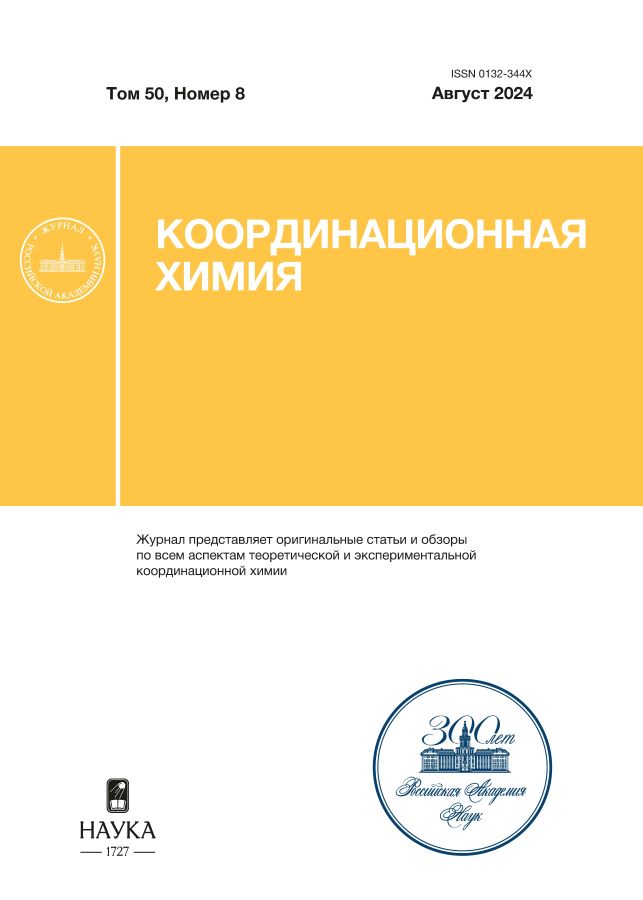MethylSulfate Complex (Bu4N)2[Мo6I8(O3SOCH3)6]: Synthesis, Structure, Lability of Ligands, and Phosphorescence
- Autores: Mikhaylov M.A.1, Sukhikh T.S.1, Sheven D.G.1, Berezin A.S.1, Sokolov M.N.1,2, Kompankov N.B.1
-
Afiliações:
- Nikolaev Institute of Inorganic Chemistry, Siberian Branch, Russian Academy of Sciences
- Novosibirsk State University
- Edição: Volume 50, Nº 8 (2024)
- Páginas: 510-519
- Seção: Articles
- URL: https://rjonco.com/0132-344X/article/view/667583
- DOI: https://doi.org/10.31857/S0132344X24080057
- EDN: https://elibrary.ru/MQZBSP
- ID: 667583
Citar
Texto integral
Resumo
New methylsulfate complex (Bu4N)2[Мо6I8(O3SOCH3)6] (I) is synthesized by the reaction of (Bu4N)2[Mo6I8(C≡C–C(O)OCH3)6] with dimethyl sulfate (CH3)2SO4. According to the XRD data, the molybdenum atoms are coordinated by the monodentate methylsulfate ligands. In a DMSO solution, the complex undergoes solvolysis accompanied by the complete substitution of the methylsulfate ligands by the solvent molecules. A powder sample of cluster I luminesces (phosphorescence) with the emission maximum at a wavelength of 620 nm (77 K). Increasing temperature to 300 K results in the shift of the emission maximum to 650 nm and a decrease in the integral intensity by 1.6 times.
Palavras-chave
Texto integral
Sobre autores
M. Mikhaylov
Nikolaev Institute of Inorganic Chemistry, Siberian Branch, Russian Academy of Sciences
Autor responsável pela correspondência
Email: mikhajlovmaks@yandex.ru
Rússia, Novosibirsk
T. Sukhikh
Nikolaev Institute of Inorganic Chemistry, Siberian Branch, Russian Academy of Sciences
Email: mikhajlovmaks@yandex.ru
Rússia, Novosibirsk
D. Sheven
Nikolaev Institute of Inorganic Chemistry, Siberian Branch, Russian Academy of Sciences
Email: mikhajlovmaks@yandex.ru
Rússia, Novosibirsk
A. Berezin
Nikolaev Institute of Inorganic Chemistry, Siberian Branch, Russian Academy of Sciences
Email: mikhajlovmaks@yandex.ru
Rússia, Novosibirsk
M. Sokolov
Nikolaev Institute of Inorganic Chemistry, Siberian Branch, Russian Academy of Sciences; Novosibirsk State University
Email: mikhajlovmaks@yandex.ru
Rússia, Novosibirsk; Novosibirsk
N. Kompankov
Nikolaev Institute of Inorganic Chemistry, Siberian Branch, Russian Academy of Sciences
Email: mikhajlovmaks@yandex.ru
Rússia, Novosibirsk
Bibliografia
- Mikhaylov M.A., Sokolov M.N. // Eur. J. Inorg. Chem. 2019. V. 2019. № 39–40. P. 4181.
- Zietlow T.C., Nocera D.G., Gray H.B. // Inorg. Chem. 1986. V. 25. № 9. P. 1351.
- Hummel T., Ströbele M., Schmid D. et al. // Eur. J. Inorg. Chem. 2016. V. 2016. № 31. P. 4938-5076. https://doi.org/10.1002/ejic.201600926
- Fuhrmann A.D., Seyboldt A., Schank A. et. al. // Eur. J. Inorg. Chem. 2017. V. 2017. № 37. P. 4259.
- Riehl L., Seyboldt A., Ströbele M. et al. // Dalton Trans. 2016. V. 45. P. 15500.
- Vorotnikova N.A., Vorotnikov Y.A., Shestopalov M.A. // Coord. Chem. Rev. 2024. V. 500. P. 215543. https://doi.org/10.1016/j.ccr.2023.215543.
- Efremova O.A., Vorotnikov Y.A., Brylev K.A. et al. // Dalton Trans. 2016. V. 39. P. 15427.
- Mironova A.D., Mikhajlov M.A., Sukhikh T.S. et al. // Z. Anorg. Allg. Chem. 2019. V. 645. № 18–19. P. 1135.
- Kirakci K., Demel J., Hynek J. et al. // Inorg. Chem. 2019. V. 58. P. 16546.
- Vorotnikova N.A., Alekseev A.Y., Vorotnikov Y.A. et al. // Mater. Sci. Eng. C. 2019. V. 105. P. 110.
- Mikhailov M.A., Brylev K.A., Abramov P.A. et al. // Inorg. Chem. 2016. V. 55. P. 8437.
- Svezhentseva E.V., Solovieva A.O., Vorotnikov Y.A. et al. // New J. Chem. 2017. V. 41. P. 1670.
- Stewart R. The Proton: Applications to Organic Chemistry. Elsevier, 1985. V. 46. P. 9. https://doi.org/10.1016/B978-0-12-670370-2.50006-2
- Schmeisser M., Heinemann F.W., Illner P. et al. // Inorg. Chem. 2011. V. 50. P. 6685.
- Blösl S., Schwarz W., Schmidt A. // Z. Anorg. Allg. Chem. 1982. V. 495. P. 177.
- Seebacher J., Mian J., Vahrenkamp H. // Eur. J. Inorg. Chem. 2004. V. 2004. P. 409.
- Li Y., Lu J., Cui X.B. et al. // Pol. J. Chem. 2004. V. 78. № 6. P. 779.
- Belokon´ Y.N., Clegg W., Harrington R.W. et al. // Inorg. Chem. 2008. V. 47. P. 3801.
- Song L. Iyoda T. // J. Inorg. Organomet. Polym. Mater. 2009. V. 19. P. 124.
- Wu J.Y., Zhong M.-S., Chiang M.-H. et al. // Chem. Eur. J. 2016. V. 22. P. 7238.
- Orysyk S.I., Bon V.V., Pekhnyo V.I. et al. // Polyhedron. 2012. V. 38. P. 15.
- Vimala T.M., Swaminathan S. // Curr. Sci. 1969. V. 38. P. 362.
- Chifotides H.T., Hess J.S., Angeles-Boza A.M. et al. // Dalton Trans. 2003. P. 4426.
- Blake A.J., Hubberstey P., Suksangpanya U., Wilson C.L. // Dalton Trans. 2000. P. 3873. https://doi.org/10.1039/B003427O
- Sokolov M.N., Mikhailov M.A., Brylev K.A. et al. // Inorg. Chem. 2013. V. 52. P. 12477.
- Sheldrick G.M. // Acta Crystallogr. A. 2015. V. 71. P. 3. https://doi.org/10.1107/S2053273314026370
- Sheldrick G.M. // Acta Crystallogr. C. 2015. V. 71. P. 3. https://doi.org/10.1107/S2053229614024218
- Dolomanov O.V., Bourhis L.J., Gildea R.J. et al. // J. Appl. Crystallogr. 2009. V. 42. P. 339. https://doi.org/10.1107/S0021889808042726
- Soto E., Helmink K.L., Chin C.P. // Organometallics. 2022. V. 41. P. 2688.
- Mikhailov M.A., Gushchin A.L., Gallyamov M.R. et al. // Russ. J. Coord. Chem. 2017. V. 43. P. 172. https://doi.org/10.1134/S107032841702004X
- Sokolov M.N., Mikhailov M.A., Abramov P.A., and Fedin V.P., J. Struct. Chem., 2012, vol. 53, no. 1, p. 200.
- Bruckner P., Preetz W., Punjer M. // Z. Anorg. Allg. Chem. 1997. V. 623. P. 8.
- Kirakci K., Cordier S., Roisnel T. et al. // Z. Kristallogr. NCS. 2005. V. 220. P. 116.
- Pronina E.V., Pozmogova T.N., Vorotnikov Y.A. et al. // J. Biol. Inorg. Chem. 2022. V. 27. P. 111. https://doi.org/10.1007/s00775-021-01914-3
- Mikhailov, M.A., Berezin, A.S., Sukhikh, T.S., et al., J. Struct. Chem., 2021, vol. 62, no. 12, p. 1896.
Arquivos suplementares
















